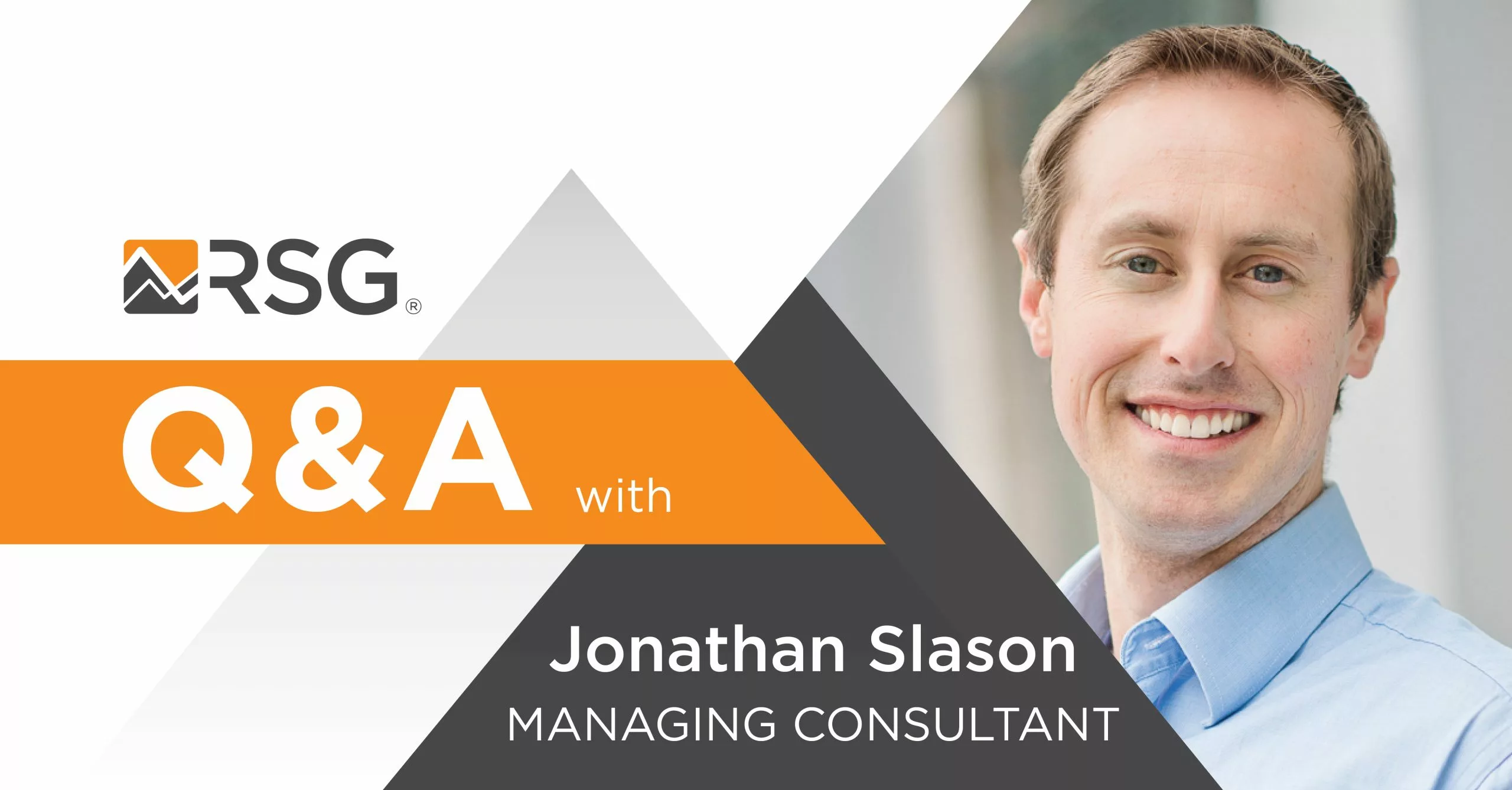
Transportation planning requires tools that balance technical rigor with practical insights to address today’s challenges, from reducing vehicle miles traveled (VMT) to promoting sustainable communities. VisionEval, an open-source modeling framework, empowers agencies to evaluate policies and investment strategies, better aligning our transportation systems with our long-term goals.
RSG has been at the forefront of VisionEval’s development and application, applying our deep expertise in travel behavior and data collection to help agencies unlock their full potential. By integrating VisionEval with other tools and customizing its capabilities, RSG helps clients turn complex planning questions into actionable insights.
We spoke with Jonathan Slason, a nationally recognized expert in helping clients apply VisionEval, to explore the origins of the tool, its standout use cases, and how RSG helps clients maximize its benefits.
Can you share how VisionEval originated and how the Oregon-Federal Highway Administration partnership contributed to its common framework?
VisionEval was developed by the Oregon Department of Transportation (ODOT). Historically, Oregon has had strong land-use planning regulations aimed at concentrating growth and encouraging sustainable land-use patterns. In the early 2000s, ODOT determined that the existing tools and methods available to them were not sufficiently capturing the influence that these land-use patterns and other related policies have on travel behavior. Based on this need, ODOT developed a tool to provide clarity in working with local communities, MPOs, and regional agencies, leading to a model that became VisionEval’s foundation.
Over time, several similar open-source models have emerged, each focused on different geographic scales and levels of detail on the inputs required. The Federal Highway Administration (FHWA), through a pooled fund initiative, unified these models into a single platform, creating VisionEval. While some legacy tools with similar functions, like GreenSTEP and the Energy and Emissions Reduction Policy Analysis Tool (EERPAT), remain as stand-alone or depreciated models, VisionEval integrates aspects of these models’ core attributes into a consistent, modular framework.
Can you describe your first experience with VisionEval and the moment when you recognized its potential for planning?
I became aware of VisionEval through my work in travel modeling and planning. Unlike other sketch modeling tools that I was using, VisionEval accounted for nuanced factors like household composition and socioeconomic factors along with considerations of the adjacent built form, making it uniquely capable of capturing the complexities of real-world travel behavior. Its flexibility and ability to model “what-if” scenarios align with my belief—and RSG’s approach—that better data leads to better decisions.
As an engineer turned planner with an economics background—and a new father at the time—I was able to translate theory into reality, better understanding how life changes, like household composition and age, dramatically influence travel behavior. For example, I shifted from daily bus use to driving to accommodate a more flexible schedule with young children. This example highlighted the benefits of tools that can better reflect such details associated with a thorough understanding of the demand for travel.

VisionEval’s household-level modeling stood out, incorporating factors like household size, member ages, employment status, vehicle ownership, land-use density, and accessibility to transit, walking, and biking. It even accounted for influences like gas prices, often overlooked by other models. Its ability to model real-world travel behavior while remaining lightweight and adaptable was a game-changer for me and our clients, allowing planners to explore and understand future travel behaviors in ways other tools could not.
Would you describe yourself as a planner or a modeler, and how has your engineering background shaped your perspective?
While I began as a civil engineer focused on traffic operations, my career has evolved to include both planning and modeling. My dual perspective aligns closely with RSG’s ethos of connecting technical rigor with practical applications, helping clients translate complex insights into actionable strategies.
My background also instilled a healthy skepticism toward models and forecasts, encouraging me to test their reliability and practicality. Early in my career, I worked on microsimulation models focused on immediate operational concerns and then expanded to corridor and subregional travel models. Over time, my interest grew to understanding how well forecasts reflect and account for the variety of other factors that can influence travel, such as gas and car insurance prices or a new major employer in the region. Those tools were not designed to answer those questions. It was at this time that I was seeking tools and methods to help our clients better understand the nature of our models and strengthen our analytical capacity to account for such questions in our work.
Collaborating with planners helped me bridge the gap between detailed operational tools and strategic planning models. My role as a translator has helped clients understand what the model results mean in real-world terms.
Over time, I’ve focused more on integrating analytical rigor into planning processes. VisionEval appeals to me and its many users because it reflects individual behaviors—factors like age, household composition, and personal preferences—through its econometric framework.
Can you share a few innovative VisionEval use cases RSG has contributed to, and how they showcase the tool’s versatility?
One notable use case is the Oregon Transportation Plan, where at the statewide level it could account for costs of investments (maintenance, new capacity) and revenues (fuel taxes and VMT fees). It simulated how different budget allocations—for transit, roadways, or traffic signals—impacted outcomes in a fixed-budget environment, showcasing VisionEval’s ability to model trade-offs and provide actionable insights. We discussed this project with our client partner during our VisionEval webinar.

Another application involved integrating VisionEval with the Integrated Transport and Health Impact Modelling Tool, or ITHIM, an open-source health impacts model. Outputs like walking and biking data were used to assess health outcomes, such as reduced emissions and crash avoidance, while accounting for risks like increased exposure, depending on the type of active mode infrastructure. This integration highlights VisionEval’s potential to address health-related planning.
We’ve also integrated VisionEval with PopSim, an open-source population synthesizer, to align long-term strategic planning with detailed population modeling. In Massachusetts, we worked with our clients to use VisionEval to develop a telework module based on data RSG had collected for our client, accounting for the eligibility of certain occupations to telework, rather than physically make the commute. Using empirical data from RSG’s household travel modeling work we were able to model how a teleworker may avoid commuting but how other travel may also change, reducing the net benefit of telework.
What is a standout use case for VisionEval, and what specific problem does it solve exceptionally well?
VisionEval is an ideal tool for agencies looking to reduce VMT or use VMT as a core performance measure. VMT per capita is a widely recognized metric for evaluating transportation systems. VisionEval helps agencies identify pathways for reducing driving trips, promoting alternative modes of transportation, or evaluating policies to reduce VMT.
VisionEval excels in long-range planning, allowing agencies to compare scenarios like building roadways for suburban sprawl versus reinvesting in urban cores to create walkable, sustainable communities. This makes it ideal for aligning transportation planning with goals such as sustainability, equity, and reduced car dependence.
VisionEval supports a “decide-and-provide” paradigm, starting with a future vision and planning infrastructure to achieve it. This approach is particularly relevant as many communities struggle to cover the costs required to maintain current roads, let alone build new ones. VisionEval offers a flexible, cost-effective tool for addressing these challenges and achieving desired outcomes.
VisionEval is open-source and free. How does partnering with RSG help agencies maximize its benefits?
VisionEval’s open-source nature offers flexibility and customization, and partnering with RSG helps agencies unlock its full potential. With our expertise in travel behavior modeling and data collection, we can enhance VisionEval’s capabilities to ensure it delivers accurate, actionable insights tailored to an agency’s needs and serve as a trusted partner to maximize the tool’s capabilities.
We streamline the process of developing base and future scenario inputs, running the model efficiently, and providing clear, meaningful interpretations of results. Our experience extends to refining core modules, updating assumptions, and aligning VisionEval outputs with broader planning objectives.
Additionally, RSG brings deep experience in visualizing outputs and integrating them into the planning process. We are the one firm who has been supporting and developing this suite of strategic models since they were first created. By partnering with us, agencies gain access to a team of expert planners, market researchers, and modelers who help them make the most of VisionEval’s powerful features to achieve their goals effectively.
What upcoming changes for VisionEval are you most excited about, and how will they enhance its functionality and usability?
VisionEval receives pooled fund support through FHWA’s oversight, which sustains its development and encourages further contributions to enhance its capabilities.
A key upcoming improvement is installation simplification, addressing a major barrier for many agencies. While the tool’s core functionality remains consistent, these updates aim to streamline the setup process and make VisionEval more accessible.
At RSG, we are excited to enhance VisionEval’s usability for our clients by developing visualizations and tools that improve input preparation and result analysis. These advancements will help users better understand and apply VisionEval’s insights, making it an even more valuable resource for planners and modelers.
What VisionEval activities, meetings, or panels are happening at the TRB Annual Meeting in January that attendees should look out for?
TRB will feature several exciting VisionEval-related activities. Presentations during the meetings for the Economics and Finance and Transportation Demand Management committees and the Climate Change Joint Subcommittee will showcase recent work exploring how shifting vehicle ownership costs from fixed to marginal affects behavior, equity, and vehicle choices, highlighting innovative applications of the tool. I would encourage anyone interested in VisionEval to attend these meetings to learn more.
I will also be in attendance and welcome the opportunity to connect with anyone interested in learning more about VisionEval and RSG’s experience helping guide clients in their use and application of this invaluable tool.
·····························
Have questions about using VisionEval for your next project? Contact us to request a consultation.









